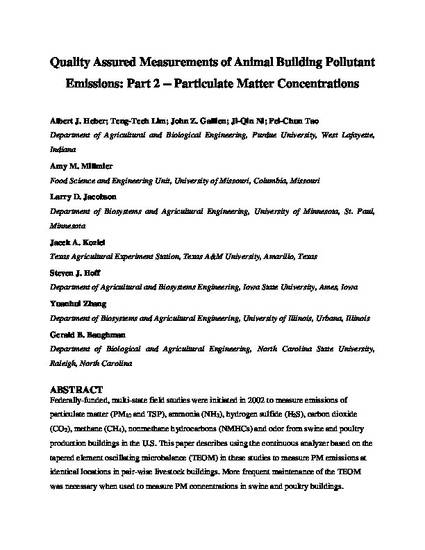
Federally funded, multistate field studies were initiated in 2002 to measure emissions of particulate matter (PM) <10 μm (PM10) and total suspended particulate (TSP), ammonia, hydrogen sulfide, carbon dioxide, methane, non-methane hydrocarbons, and odor from swine and poultry production buildings in the United States. This paper describes the use of a continuous PM analyzer based on the tapered element oscillating microbalance (TEOM). In these studies, the TEOM was used to measure PM emissions at identical locations in paired barns. Measuring PM concentrations in swine and poultry barns, compared with measuring PM in ambient air, required more frequent maintenance of the TEOM. External screens were used to prevent rapid plugging of the insect screen in the PM10 preseparator inlet. Minute means of mass concentrations exhibited a sinusoidal pattern that followed the variation of relative humidity, indicating that mass concentration measurements were affected by water vapor condensation onto and evaporation of moisture from the TEOM filter. Filter loading increased the humidity effect, most likely because of increased water vapor adsorption capacity of added PM. In a single layer barn study, collocated TEOMs, equipped with TSP and PM10 inlets, corresponded well when placed near the inlets of exhaust fans in a layer barn. Initial data showed that average daily mean concentrations of TSP, PM10, and PM2.5concentrations at a layer barn were 1440 ± 182 μg/m3 (n = 2), 553 ± 79 μg/m3 (n = 4), and 33 ± 75 μg/m3 (n = 1), respectively. The daily mean TSP concentration (n =1) of a swine barn sprinkled with soybean oil was 67% lower than an untreated swine barn, which had a daily mean TSP concentration of 1143 ± 619 μg/m3. The daily mean ambient TSP concentration (n = 1) near the swine barns was 25 ± 8 μg/m3. Concentrations of PM inside the swine barns were correlated to pig activity.
Available at: http://works.bepress.com/steven_hoff/158/

This is an Accepted Manuscript of an article published by Taylor & Francis as Heber, Albert J., Teng-Teeh Lim, Ji-Qin Ni, Pei-Chun Tao, Amy M. Schmidt, Jacek A. Koziel, Steven J. Hoff, Larry D. Jacobson, Yuanhui Zhang, and Gerald B. Baughman. "Quality-assured measurements of animal building emissions: Particulate matter concentrations." Journal of the Air & Waste Management Association 56, no. 12 (2006): 1642-1648. Available online DOI: 10.1080/10473289.2006.10464569. Posted with permission.